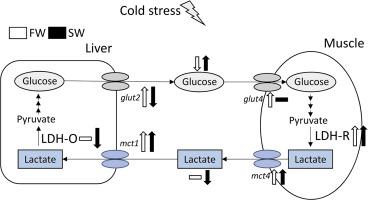Comparative Biochemistry and Physiology A: Molecular & Integrative Physiology ( IF 2.1 ) Pub Date : 2020-06-20 , DOI: 10.1016/j.cbpa.2020.110744 Chia-Hao Chang,Xiu-Wei Zhou,Yu-Chun Wang,Tsung-Han Lee

|
The milkfish Chanos chanos, an economically important cultured marine species in Southeast Asia, exhibits stenothermal and euryhaline characteristics and huge mortality usually occurs during extreme cold weather in winter. Under conditions beyond optimal temperatures, ectothermic species experience an increase in anaerobic glycolysis. To better understand the hypothermal acclimation response of this tropical species, the lactate metabolic profiles of freshwater (FW)- and seawater (SW)-acclimated milkfish were compared under control (optimal temperature; 28 °C) and hypothermal treatment (18 °C) conditions. In this study, the lactate dehydrogenase (LDH) isoform genes, ldha and ldhb, were identified in milkfish livers and muscles, respectively. The LDH is a bidirectional enzyme that triggered the conversion of pyruvate to lactate via anaerobic glycolysis as LDH exhibits the reductase activity (LDH-R), while via the reverse direction as LDH exhibits the oxidase activity (LDH-O). The hypothermal stress significantly upregulated the LDH-R activity in the muscles and the monocarboxylate transporter activity in both muscles and livers, of SW- and FW-acclimated milkfish. The levels of blood lactate, however, decreased in SW-acclimated milkfish. Under hypothermal stress, anaerobic metabolism increased in the muscles of both FW and SW individuals, whereas the liver of SW-acclimated milkfish showed better acute phase capacity to utilize blood lactate than FW-acclimated milkfish. Taken together, in the present study, the major functions of the bidirectional enzyme LDH were identified according to its LDH-O and LDH-R activities. Furthermore, environmental salinities were found to affect the acute anaerobic metabolic strategies of euryhaline teleosts under hypothermal stress and were correlated with their hypothermal tolerance ability.
中文翻译:

低温胁迫对淡水和海水适应的遮目鱼Chanos chanos乳酸代谢的不同影响。
遮目鱼Chanos chanos是东南亚经济上重要的养殖海洋物种,具有狭窄的热力和鱼腥草的特征,通常在冬季极端寒冷的天气中会发生巨大的死亡。在超出最佳温度的条件下,外热物种的厌氧糖酵解增加。为了更好地了解该热带物种的低温适应性反应,在对照(最佳温度; 28°C)和低温处理(18°C)下比较了淡水(FW)和海水(SW)适应的遮目鱼的乳酸代谢谱。条件。在这项研究中,乳酸脱氢酶(LDH)亚型基因ldha和ldhb分别在遮目鱼的肝脏和肌肉中发现。LDH是一种双向酶,它通过厌氧糖酵解触发丙酮酸转化为乳酸,因为LDH表现出还原酶活性(LDH-R),而通过相反方向表现出LDH表现出氧化酶活性(LDH-O)。低温使SW和FW适应的遮目鱼肌肉中的LDH-R活性和肌肉和肝脏中的单羧酸转运蛋白活性显着上调。然而,适应SW的遮目鱼的血乳酸水平降低了。在低温胁迫下,FW和SW个体的肌肉中厌氧代谢增加,而SW适应的遮目鱼的肝脏显示出比FW适应的遮蔽鱼更好的急性期利用血液乳酸的能力。总而言之,在本研究中,根据LDH-O和LDH-R的活性鉴定了双向酶LDH的主要功能。此外,环境盐度被发现会影响低温胁迫下鱼腥草硬骨鱼的急性厌氧代谢策略,并与其耐低温能力相关。











































 京公网安备 11010802027423号
京公网安备 11010802027423号